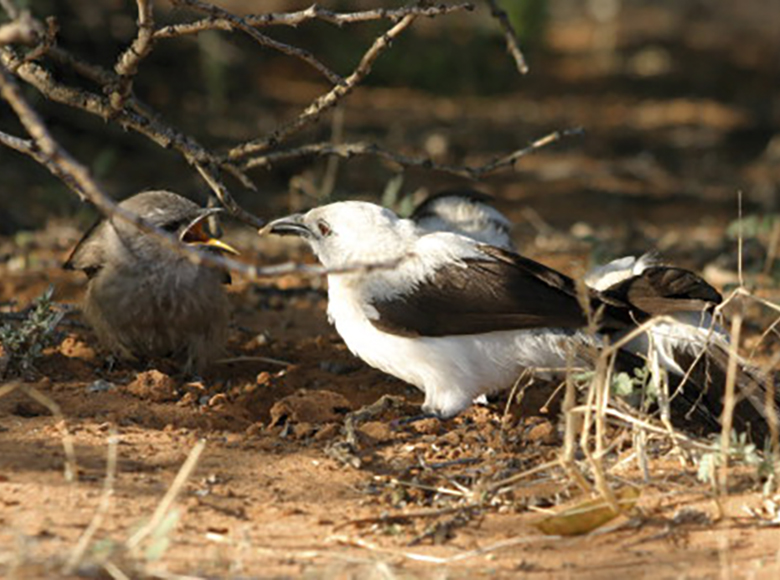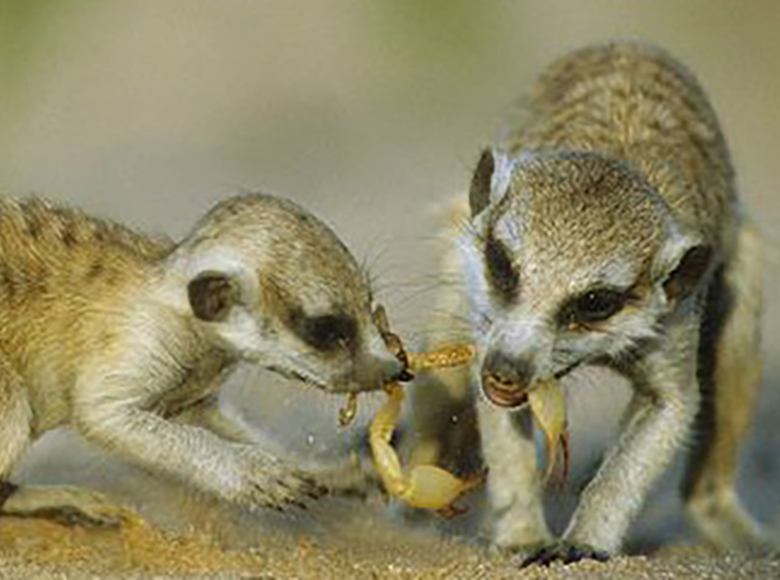The evolution of anti-teaching
by James Allen
3 December 2018

Adult pied babblers teach fledglings to associate specific calls to food delivery. Image: AN Radford, from Rapaport LG, Current Biology (2006).
In 1921 a British tit was observed opening a milk-bottle to eat the cream inside, and over the next 26 years this unique innovation spread to over 30 different sites. As just one example out of hundreds, this shows how animal populations contain a mixture of innovation and learning, with novel behaviors discovered, developed and spread through social learning. The question is, if these behaviors are advantageous to learn, are they ever adaptive enough for a demonstrator to teach?
The perfect example of how teaching manifests itself in nature can be found in meerkats. Meerkats have a wide-ranging diet, including potentially dangerous prey such as scorpions. Learning to consume scorpions individually is particularly dangerous, so adults have been observed to teach by allowing their pups to interact with prey in decreasing states of damage. By defining teaching as a demonstrator enhancing the learning of a naive observer at a cost (or no direct/immediate benefit) to themselves, both theoretical and empirical work show that teaching is adaptive in a small number of other, very different species, from ants and bees, to pied babblers, and it is therefore well established that it can be advantageous to increase the learning rate of others at a cost to yourself. However, this raises a question that we have been working on: if a demonstrator can increase the learning rate of an observer at a cost, might they also decrease it?
We answer this question using a theoretical model. By stripping systems down to their most basic parts models can suggest previously undiscovered novel behaviors, propose when we would expect to observe them, and discover their key drivers. In our model we assume that individuals can be locally skilled or unskilled: we do not specify precisely what the skill might be, and examples could range from simple information (the location of a particularly good food source, for example) to more complex hunting skills. Individuals can alter the rate at which unskilled individuals learn through an additional costly teaching effort. Positive teaching efforts allow unskilled observers to learn more quickly, but increased teaching efforts improve learning rates at an increased cost to the demonstrator. The exciting addition to our model is the ability to exhibit costly negative teaching efforts, which decrease the observer’s learning. These negative teaching efforts we label anti-teaching.
To discover whether anti-teaching could ever be adaptive, we form a set of equations that calculate the fitness of each individual for a certain teaching effort, where higher fitness means a particular teaching effort is more likely to spread throughout the population. We then ask, if we introduce a mutant with a slightly different teaching effort (either positive or negative), is this mutant fitter? If it is, we assume that it spreads throughout the population; if it’s not, it dies out (a technique known as ‘adaptive dynamics’). By slowly repeating this process until no mutant improves an individual’s fitness, we find that both teaching and anti-teaching are adaptive, though each under different conditions. Put another way, under certain circumstances animals may reduce the learning rate of another, even at a cost to themselves. The main reason that anti-teaching is adaptive is the competition between skilled individuals. Each individual increases their fitness by maximizing the number of offspring they have, a feat best achieved through ensuring others remain unskilled.

Adult meerkats teach youngsters how to handle dangerous prey.
Our model suggests that anti-teaching is potentially just as adaptive as teaching might be, but unlike teaching, anti-teaching has not yet been observed in animals. But, what might it look like? In our model, the skill is not specified, and as mentioned above may be anything from knowledge of a beneficial location to a complex tool. Starting very simply, anti-teaching could manifest itself as an individual depleting a resource, or using a tool when others are not watching. Using tactical deception, animals are already known to deceive others as to the location of certain foods, whilst other examples of deception include deceptive mate choice in Atlantic mollies: if a male is observed by a competitor he will select a lower quality female than he would otherwise have done. However, we suggest that anti-teaching may be extended to skills as well as information. In more complex cases anti-teaching may be performing a skill in a way that is more difficult to imitate, or even interfering or scaring away others when the skill is being performed. In short, we envisage this behavior as anything that decreases social learning at a cost to the demonstrator. Examples could include such behavior as performing a task only when others are not looking, an individual turning their back away from others when performing a task, or performing a task differently/more quickly when others are around. It is also worth remembering that in general, teaching is performed between related tutors and learners, whilst in our model we would expect the behavior to be observed largely between unrelated individuals.
Anti-teaching may also explain a mystery inherent in the study of teaching: why is it that teaching is so prevalent in humans, but not in our closest relatives? There are already some proposed explanations for the lack of observation of teaching in chimpanzees, one of which being that the extensive opportunities for social learning means there is little need to incur the cost of teaching. We propose another possible explanation. Our model suggests that we would expect anti-teaching when offspring are likely to disperse, thereby resulting in low relatedness between individuals in the same environment. Interestingly, the life-histories of apes, with their frequent group formation and dissolution, closely match these conditions. Therefore, we suggest that it is the presence of anti-teaching, possibly alongside teaching between parents and offspring, that could make teaching difficult to observe in chimpanzees.
What our model suggests is that alongside the well-studied positive spread of knowledge and culture within animals, there might be a less studied restriction of the spread of knowledge. We suggest that there are species actively discouraging learning, even at a cost to themselves, sometimes only performing tasks when alone, sometimes actively preventing others from being able to imitate them.
Manuscript in preparation: Johnstone RA and Allen J. The evolution of anti-teaching.
This work is part of project #11 in the EES research program, entitled Evolution of extra-genetic inheritance: A life-cycle perspective, under the theme Inclusive Inheritance.